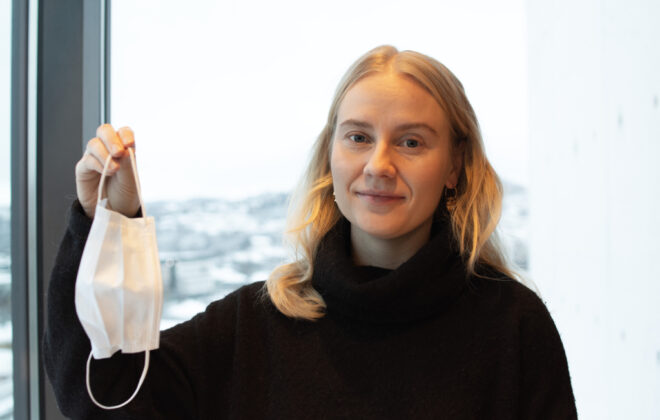Why I eat insects
This summer my fellow student at Industrial Ecology, Ida Hexeberg Rustad and I decided to found a company, Myldregard AS. The company is based on an idea we both have carried for years. Some would say that the concept is controversial and many have reacted with scepticism. The idea is simple; to offer insects for human consumption.
We are aware that many have a hard time imagining themselves eating insects. Yet we still have gotten surprisingly much attention. Despite the lack of tradition for this in Norway, many have contacted us asking when the production is up and running, and where they can buy our products.
To understand why some are sceptical, I constantly have to remind myself how unnatural this diet was for me only a few years ago.
So, what are the benefits?
There are many reasons for eating insects. By not including it in our diet we are actually missing out on healthy and tasty food. Insects are a sustainable source of proteins and favourable for the environment. Additionally, they have high nutritional value, rivalling other sources, such as meat.
Eating insects is not new behaviour for humans. Entomophagy, which means human consumption of insects, has long traditions in many regions of the world. And with good reason, as this healthy food is quite feed efficient and has low environmental impacts. So I find it a bit strange that we are not already utilizing this resource, also in the western part of the world.
After first hearing about entomophagy I have gradually become aware of the great variety of dishes and ways to eat insects. Originally, I looked at entomophagy as a way of consuming animal proteins more ethically. Now however, I see it as a tasty and intriguing way to add variety to my diet.

A FAO (Food and Agriculture Organization of the United Nations) report from 2013 explains the health and environmental benefits of entomophagy. In the next sections I will briefly summarize some of the key findings. (FAO, 2013a)
Environmental benefits
Many are already aware that our diet contributes significantly to our impact on climate. Livestock is responsible for 14.5 percent of total man-made greenhouse gas (GHG) emissions (FAO, 2013b). This indicates that changing our diet to consuming less of the emission-intensive products, and more of the lower emitting products, can contribute to significantly lower GHG emissions.
As the amount of meat the average Norwegian consumes a year is 80 kg, it should be possible to cut back a bit (Helsedirektoratet, 2014a). According to Helsedirektoratet, it is estimated that we consume an average of 560g of red meat (pork, cattle, sheep and goat) a week. While it is recommended that we stay below 500g to avoid negative health effects. (Helsedirektoratet, 2014b)
As with meat from animals, environmental impacts from insects vary depending on species and rearing methods. In its report, FAO presents a study that compares these impacts from different kinds of animals and insects.
Both grasshoppers and mealworms are quite common within entomophagy. We in Myldregard have chosen to focus on mealworms.
The figure below, taken from FAOs report, shows the amount of GHGs that are produced per kg of mass gain for insects and animals. This study shows that cattle are clearly the most emission intensive and that the three insects all perform better than the animals.

In addition to being environmentally friendly, it is considered to be a possible resource to meet the growing food demand. This is due to its high feed-conversion efficiency. Per kg of increase in weight crickets need about 1.7 kg of feed. For chicken its about 2.5 kg, pork: 5 kg and cattle: 10 kg. Since you cannot eat the entire animal, it is fitting to look at kg of feed required per kg of edible weight, as opposed to the total weight. As seen in the figure below, the percentages of the animal that can be used as food vary between the different animals. The figure shows that you can eat a much larger percentage of a cricket than of the animals. When adjusted for edible weight crickets are twice as efficient as chicken, four times more efficient than pigs and 12 times more feed efficient than cattle.

Nutritional values
So the environmental benefits are clear, but can this somewhat special cuisine compare with the nutritional values of meat?
According to FAO, yes.
It is important to note that the nutritional values of insects vary a lot depending on species and on feed. Nevertheless, they still conclude that many edible insects are a good alternative to traditional meat as a source of protein. In one of the studies FAO presents, nutritional values of mealworms have been compared with nutritional values of cattle. It is important to note that these numbers are based on a single study and that diet and rearing methods will affect these values.
The report presents quite detailed information about different nutrients. To keep this blog post in a readable length I will only render the overall conclusions here. For more comprehensive information, I recommend you to look at the report from FAO.
In the study, content of protein, fat and metabolized energy (kcal/kg) in dry matter are compared. The values are as follows:
- Beef – 55.0% protein, 41.0% fat and 2820 kcal/kg
- Mealworm – 49.1% protein, 35.2% fat and 2056 kcal/kg
The study also finds that “Mealworms contain comparable values of copper, sodium, potassium, iron, zinc and selenium” and “Mealworms have generally higher vitamin content than beef, with the exception of vitamin B12”.
Overall, the report concludes that the nutritional contents of insects sufficiently satisfy our needs, and that insects are an adequate alternative to traditional meat as a source of nutrition.

So, why not?
For some reason the act of eating insects gives a feeling of disgust to most Norwegians. This is relatable to me as I also considered it unnatural the first time I was exposed to this diet. However, ever since I first heard of entomophagy the idea have been swirling around in my head, and at some point it started feeling normal. Now I don’t feel the slightest bit of disgust when eating a well-prepared insect. Actually quite the opposite.
I realize that changing people’s perception of insects as food is a hard fought battle.
It seems that we have been brought up with this idea that insects are disgusting and maybe even dangerous for us to eat. And that this has created some kind of psychological barrier against eating insects. At the same time I am pleasantly surprised by the amount of open-minded people who are eager to try out this untraditional cuisine.
Especially food enthusiasts seem particularly keen on trying out insects, and see this as an opportunity to discover new and tasty dishes.
Myldregard would simply like to offer this product to Norwegian consumers. Our hope is that people will look at this as an intriguing way to add variety to their diet. As with the story of sushi, we hope that people eventually will enjoy their insect meals with great pleasure and satisfaction.
Sources
FAO, 2013a. Food and Agricultural Organization of the United Nations. “Edible insects – Future prospect for food and feed security”
FAO 2013b. Food and Agricultural Organization of the United Nations. “Tackling climate change through livestock – A global assessment of emissions and mitigation opportunities”
Helsedirektoratet, 2014a. “Utviklingen i norsk kosthold 2014”
Helsedirektoratet, 2014b
www.helsenorge.no ”Velg magert kjøtt”
This blog post was originally published on January 20th, 2016 on www.ntnutechzone.no

Victoria Stokke
Victoria Stokke is a student in Industrial Ecology at NTNU and a co-founder of Myldregard.
Tags In
Search
Søk
Categories
- Arctic Research
- Arkitektur
- Bærekraft
- Bioingeniørfag
- Biologi
- Biology
- Biomedical Laboratory Science
- Biotechnology
- Bioteknologi
- Chemical Engineering
- Chemistry
- Climate
- Computer Science
- Datateknologi
- Digital
- Elektronikk
- Energi
- Energi
- Energy
- Engineering
- Engineering
- Environment
- Food Science
- Forskning
- Fysikk
- Fysikk
- Havbruk
- Informasjonsteknologi
- Informasjonsteknologi
- Ingeniørvitenskap
- Kjemi
- Kjemisk prosessteknologi
- Kjemisk prosessteknologi
- Kreftbehandling
- Kybernetikk
- Marine Technology
- Materialer
- Materials Science
- Materialteknologi
- Matvitenskap
- Meninger
- Miljø
- Min ph.d.
- My PhD
- My PhD
- My postdoc
- Nanotechnology
- Nanoteknologi
- Ocean
- Oil and gas
- Physics
- Research
- Simulering og visualisering
- Spør en forsker
- Studentliv
- Sustainability
- Ukategorisert
- Universitetsliv
- University Life
Kategorier
- Arctic Research
- Arkitektur
- Bærekraft
- Bioingeniørfag
- Biologi
- Biology
- Biomedical Laboratory Science
- Biotechnology
- Bioteknologi
- Chemical Engineering
- Chemistry
- Climate
- Computer Science
- Datateknologi
- Digital
- Elektronikk
- Energi
- Energi
- Energy
- Engineering
- Engineering
- Environment
- Food Science
- Forskning
- Fysikk
- Fysikk
- Havbruk
- Informasjonsteknologi
- Informasjonsteknologi
- Ingeniørvitenskap
- Kjemi
- Kjemisk prosessteknologi
- Kjemisk prosessteknologi
- Kreftbehandling
- Kybernetikk
- Marine Technology
- Materialer
- Materials Science
- Materialteknologi
- Matvitenskap
- Meninger
- Miljø
- Min ph.d.
- My PhD
- My PhD
- My postdoc
- Nanotechnology
- Nanoteknologi
- Ocean
- Oil and gas
- Physics
- Research
- Simulering og visualisering
- Spør en forsker
- Studentliv
- Sustainability
- Ukategorisert
- Universitetsliv
- University Life



